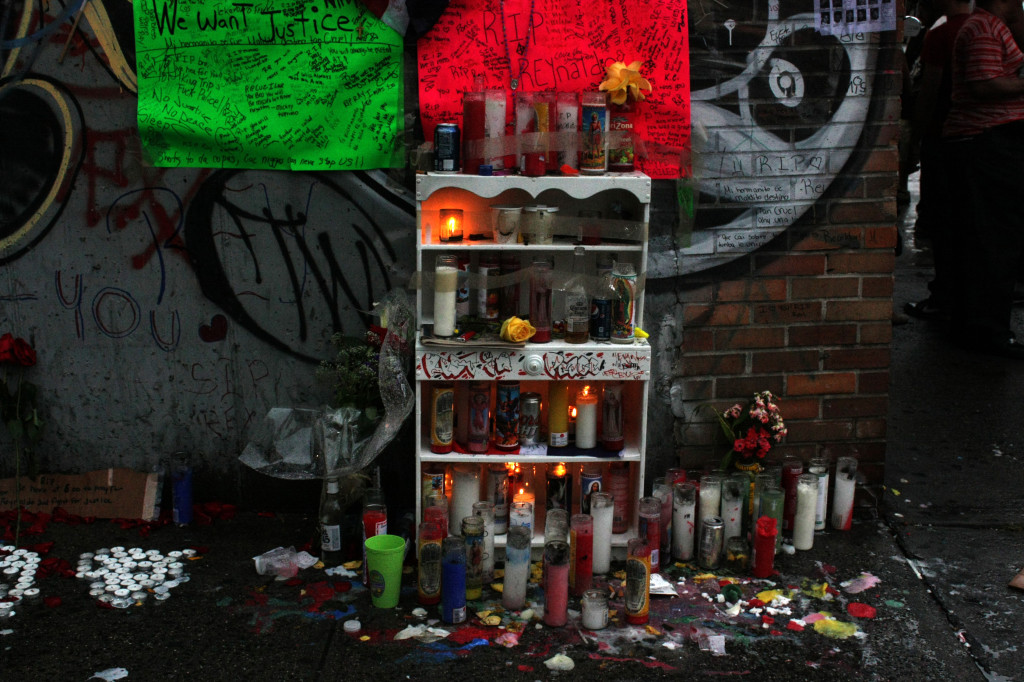Clergy works to calm activists as anti-NYPD feelings rage
Rain began falling Saturday night just as Rev. Ruben Austria led a passionate prayer for justice and healing in the aftermath of a botched robbery that left a 20-year-old bodega worker dead from police gunfire.
Huddled in a tight circle at 169th Street and Franklin Avenue, roughly 50 mourners — family members, friends and community activists — turned out Saturday night in honor of Reynaldo Cuevas, the young father from the Dominican Republic accidentally shot by police during a robbery scuffle early Friday morning.
“We want to stand in solidarity with the family and pray that our outrage doesn’t lead to in-rage. That it doesn’t cause us to consume ourselves and tear one each other down,” Austria told the group, with he and fellow clergy starting a chorus of “Hallelujah.”
Rally participants gathered around a makeshift memorial draped with flowers, rosaries and hand-scribbled notes across from Aneurys Daily Grocery in the Morrisania section of the Bronx. Cuevas worked six nights a week at the store, often staying for 16-hour shifts.

Community activists joined cousins of Reynaldo Cuevas in a prayer vigil Saturday night. “We want to stand in solidarity with the family and pray that our outrage doesn’t lead to in-rage,” Rev. Ruben Austria said. (ADAM PEREZ / The Bronx Ink)
The memorial included a few dollar bills, some cigarette butts and a lottery ticket — the type of loot the armed robbers tried to make off with in a backpack before police arrived.
Around 1:50 a.m. Friday, Cuevas, in an “understandable panic to get away from the gunman as fast as possible,” ran outside the bodega to escape the masked robbers and collided with a police officer, according to Police Commissioner Raymond Kelly, and the officer accidentally fired his weapon, striking Cuevas in his left shoulder. He died at St. Barnabas Hospital.
“I want to extend my condolences to the Cuevas family for their loss,” Kelly said in a statement Friday. Kelly emphasized the events had transpired in “split seconds.”
Some came to the Saturday night rally simply to mourn the loss of Cuevas, described by relatives as a kind-hearted young man who’d been saving to send money to his 3-year-old daughter, Jamie, in the Dominican Republic.
“He was hard-working and humorous and caring,” said Ashley Rodriguez, 14, a cousin of Cuevas. She said she last saw Cuevas two days before his death, when he helped her get through some issues she was facing with high school. Cuevas was a good listener, she said, and he urged her to stay focused on her studies.

Reynaldo Cuevas, 20, worked nights at the bodega, saving money for his 3-year-old daughter, Jamie, in the Dominican Republic.
“How many parents got to bury their kids? When is this really going to stop?” said Juanita Young, an activist with Families of Stolen Lives and Parents Against Police Brutality. “I am so angry at what just happened here — that young man just trying to make a life for him and his family … When is enough enough?”
The candlelit vigil, announced via a cardboard sign at the memorial site and on a Facebook page for Cuevas created Saturday, also drew activists from the New York Civil Liberties Union and Stop “Stop and Frisk” Freedom Fighters, who oppose the NYPD’s controversial tactic of searching people on the streets over concerns police disproportionately target people of color.
“People are out here not just for this incident, but because I think what everybody feels and knows and understands is there’s been years of police harassing and targeting young black and Latino men,” Austria said.
Ashley Rodriguez said she’s not sure her cousin’s death represents a bigger problem; she just wants to see an investigation into the officer who shot him. For now, she wants that officer suspended.
“It’s uplifting to know that even people that didn’t know him are supporting us because they know this wasn’t right,” said Mary Rodriguez, 24, another cousin of Cuevas who was wearing an anti-“Stop and Frisk” button.
A downpour dispersed the crowd on Saturday, with some activists announcing plans to reschedule a march for Wednesday, and to attend a funeral for Cuevas on Monday.
Saturday’s event was the second emotional vigil honoring Cuevas this weekend. On Friday night, after the news vans and most reporters had left, the crowd erupted into angry shouting at the police, who stood quietly across the street. Austria was there, too, working to calm the small crowd for several hours and prevent the scene from escalating into a violent confrontation with the officers.
“The police have to be held accountable when they use excessive force, but we have to hold ourselves accountable. The community’s got to hold each other accountable because the violence between us is unacceptable just as well,” Austria said. “Nobody gets a pass for doing wrong.”
Staff writers Sadef Kully, Adam Perez and Jan Hendrik Hinzel contributed to this report.




 Two days before Hurricane Irene slammed into New York City, evacuation expert Maria Forbes was told by city’s emergency coordinators to prepare for a possible disaster.
Two days before Hurricane Irene slammed into New York City, evacuation expert Maria Forbes was told by city’s emergency coordinators to prepare for a possible disaster.





